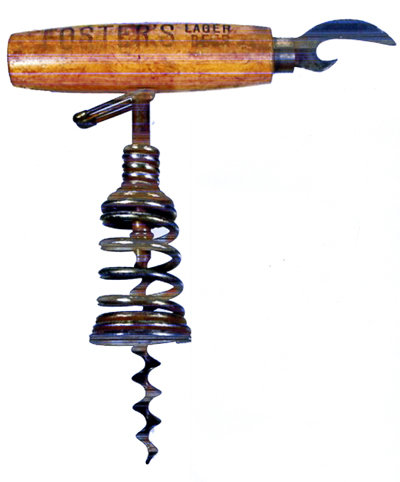SOMMERS –TYPE SPRING BARREL CORKSCREW WITH CROWN OPENER AND AUSSIE ADVERTISEMENT Brian May
Description of corkscrew
When this fearsome corkscrew comes out, the kids in the neighbourhood run.
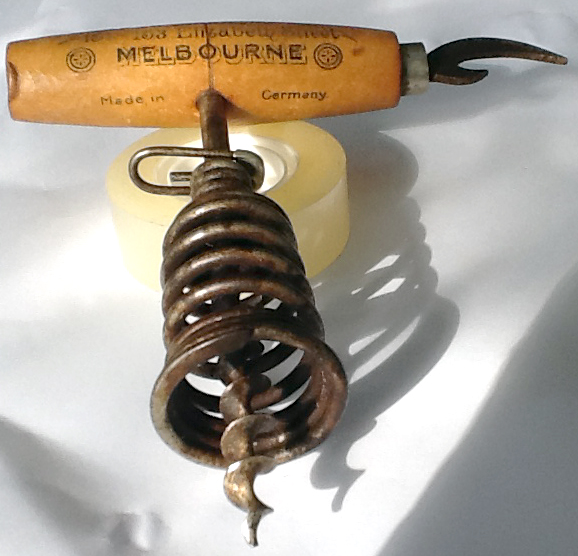
It is a German spring barrel W Sommers-type corkscrew with a nice wooden handle and attached crown opener.
The crown opener was for removing caps (crown cork seals) from bottles with carbonated contents under pressure (soft drinks and beer), the great invention of William Painter in Baltimore in 1891. The spike on the crown opener could be used to break the wire holding down a cork on a carbonated beverage bottle. I have also read that this spike on the opener served to puncture the cap so that it could not be used again.
The corkscrew has a paper clip with a pin that serves as a locking/unlocking device allowing easy removal of the cork from the worm.
Sommers and Schmalkdalden
This paper clip mechanism was the invention of W Sommers from Schmalkalden. Sommers obtained a German Registered Design No. 35,418, on 14 January 1895 for the corkscrew and this lasted three years. He then registered the same corkscrew on 11 April 1899, German Registered Design No. 114,369.
Schmalkalden is a medieval town located on the Schmalkalden River, at the southern edge of the Thuringian Forest in the central German state of Thuringia (Thuringen). With rivers and rich iron-ore deposits nearby, this town and others in the area have for centuries been involved in the manufacture of ironmongery goods of all sorts
Sommers’ spring barrels can be marked on the wooden barrel with DRGM No. 35,418 or DRGM 114, 369. My corkscrew is an un-marked example of the Sommers’ registration. I assume it was manufactured in the workshop of Sommers sometime after both registrations expired.
Advertising and Arnold Bros
The corkscrew here carries advertising. It is marked on the handle ARNOLD BROS 151 and 153 Elizabeth Street Melbourne and underneath the handle Made in Germany.
Arnold brothers, Alan and Arthur, started a business in 1891 by buying a large retail establishment at Errol Street, North Melbourne. In 1901, they moved into the heart of Melbourne and bought out a large firm at Nos 151 and 153 Elizabeth Street. This developed into a massive wholesale general groceries store that also sold a large range of leading brands of wines, spirits and beers.
In 1812, they marketed for the first time their famous A.B. WINE TONIC that became well known and sold throughout Australia. The tonic was made from beef, malt extract, fine old wine etc. and had “wonderful recuperative and sustaining qualities” that also “feeds the wasted tissues and builds up the system”.
The advertisements below for Arnold’s describe a patent corkscrew and appeared in the Melbourne paper The Argus in February 1914 and June 1915:
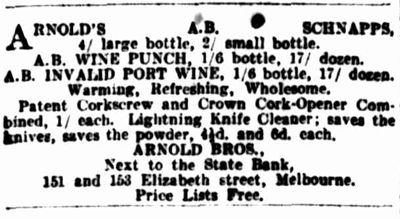
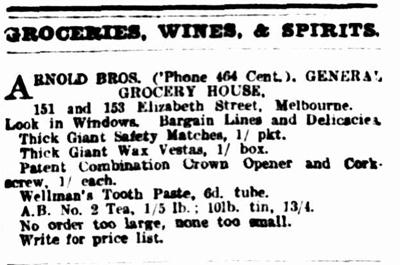
Is the patent combination crown opener and corkscrew that sold for one shilling in 1914 and 1915, my corkscrew? Almost certainly but with WWI beginning in 1914 and anti-German sentiment felt by many Australians, it is unlikely that the corkscrew displayed the marking of Made in Germany during the years of 1914 or 1915. So my corkscrew was made before 1914. In this regard Ian Hunter has an identical corkscrew to the image above but with the Made In Germany scratched out. Hence the batch containing my corkscrew was sold during the war years.
In 1918, ARNOLD BROS sold the business at 151 and 153 Elizabeth Street and closed their doors on July 1, immediately opening stores in Flinders Lane, Melbourne and trading as Wholesale Wine and Spirit Merchants.
Ian Hunter has pointed out that the Sommers’ corkscrew marked Arnold as shown here, also comes with a spike rather than a crown opener. The spike would have preceded the cap lifter. Ian says it was about 1910 that the crown seal was replacing the cork as the preferred method of sealing beer and other carbonated beverages in Australia. The date of the cap lifter version is therefore about 1910-18. The one with the spike could be a little earlier. As indicated, the spike was for breaking a wax seal or breaking wire holding down a cork on a carbonated beverage bottle.
A more common promotional item using this version of Sommers’ corkscrew showed advertising for the Australian lager Fosters, and carried the words Foster’s Lager Beer and Made in Germany. As shown below, this item came again with either a spike (the Foster’s advertising has faded, but see image in Don Bull’s The Ultimate Corkscrew Book page 154) or a cap lifter.
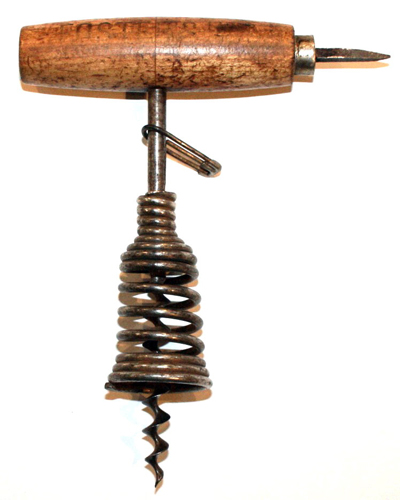
Acknowledgements: Many thanks to Ian Hunter, always a gold-mine of information. Also thanks to Peter Borrett and Ferd Peters whose images I have used.

